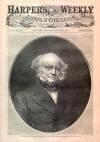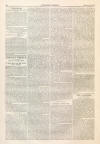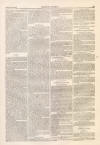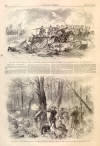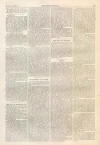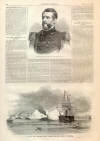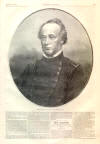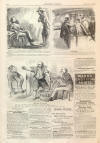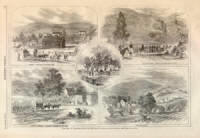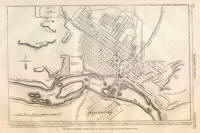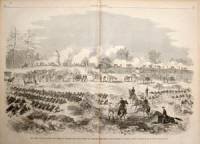Battle of Charles City Road
|
|
This Site:
|
AUGUST 9, 1862.] HARPER'S WEEKLY. 503 THE ARMY OF THE POTOMAC.WE continue in this number the reproduction of Mr. Waud's sketches of the six days' fighting before Richmond. On page 500 we illustrate A CHARGE OF THE FIFTH CAVALRY.Mr. Waud writes: "The Fifth Regular Cavalry, and small portions of some other cavalry regiments, made a dashing charge in the course of the afternoon of Friday, 28th, at the battle of the Chickahominy. Sweeping down upon the enemy, they drove the gunners from a battery, and riding along the lines of infantry, discharged their pistols in the faces of the soldiers. They suffered severely in officers and men, next day but one officer being able to report for duty. They expected that reinforcements would follow their charge, but none arrived; so, cut to pieces and dispirited, they returned, leaving behind the battery they had captured. It is superfluous to say that the Fifth was considered the finest cavalry regiment in the service." On the same page we give a picture of KEARNEY'S DIVISION AT WORKon Monday, June 30. Mr. Waud says: "In a fight, such as is represented in the picture, it is impossible to get a view of an extended line of battle from any one point. A majority of the battles so far have been of this description, usually termed bushwhacking—very deadly, but hardly affording a chance for a display of tactics. For the rest, the picture describes itself, and gives a good idea of what our soldiers have to stand up to in the Virginia swamps and woods." On pages 504 and 505 we reproduce a picture representing the BATTLE OF CHARLES CITY ROAD,fought on Monday, June 30. Mr. Waud writes: "For Franklin's division this portion of Monday's fighting was altogether an 'artillery duel'—one of the sharpest and most important of this eventful week. Porter's First Massachusetts Artillery alone hurled from 500 to 600 shells and spherical case-shot upon the enemy from this point, part of the time at only 200 yards' range. Upton's battery of brass Napoleons also fired with telling effect, although not so hotly engaged as the First Massachusetts, the enemy having gained the range of the latter battery with great accuracy during a portion of the action. This was one of the most desperate situations our army occupied in falling back upon the James River, and nothing but the savage endurance of our troops saved these divisions from destruction and capture. Slocum's heavy artillery fire, and the stubborn front which Kearney presented against greatly superior numbers, keeping the rebels at bay, and finally repulsing them with great slaughter, enabled these troops to retire upon the James River before the exhausted rebels had a thought of renewing the, for us, unequal contest. "In this battle our troops were attacked on three sides, and on our left the pressure was so heavy that when Kearney's jaded troops fell back before heavy reinforcements of the rebels, the Confederate shell flew right across the ground held by our army into their own lines beyond the right. This did not last long. Kearney's soldiers, supported by the New Jersey brigade of Slocum's division, soon recovered the lost ground. "In the sketch, Upton's on the left, and Porter's artillery to the right, are represented on a ridge gradually silencing the rebel fire; below the ridge the limbers and caissons; behind the left-hand caisson Doctors Davis and Ohlenschlager, with ambulances and medicine-chests; and, still nearer, the supporting regiments of infantry. On the left the veteran Sixteenth New York, in the white straw-hats so kindly presented to them by the Colonel's thoughtful lady—that Sixteenth whose return of casualties shows the astonishing record of only 12 missing to 228 killed and wounded, a proportion far below the average of most other regiments. On the right, lying down for better protection, like the Sixteenth, is another good regiment, the Twenty-seventh New York, and this is all that the nature of the country permits the artist to represent in one view; for when nearly all the fighting is done in the woods little can be seen at one glance." THE CITY OF RICHMOND, VA.ON page 502 we publish a plan of the CITY OF RICHMOND, VIRGINIA, from a drawing made by a Union refugee who has just made his escape. He describes the city as follows: "Like ancient Rome, Richmond stands upon seven hills, of which two, with an intervening valley, form the principal part of the city. "Shockoe Hill contains that section to the northwest of which Broad Street forms the main artery, and Church Hill the part traversed by Main Street. These are the two principal business streets. The city is truly beautiful; its resemblance to Baltimore, particularly in the vicinity of Monumental Square, is very striking. "The Capitol grounds are a highly-elevated symmetrically-sloping piece of ground, containing perhaps six or ten acres, in the centre of which the Capitol, an old stuccoed building, rears its insignificant pile; but whatever this unpretending, inadequate building lacks in elegance is redeemed by the colossal bronze equestrian statue of General Washington, who, from his high granite pedestal, looks ever peaceful and serene, like an ancient god, upon the ungodly crowd below him, his right arm gracefully stretched out, while his finger points to the distant west. A secession friend, while contemplating this master-piece of art, remarked to me, in a candid, jocular vein, that General Washington, while looking upon the rebel Congress, significantly points toward the penitentiary, which in reality rears its massive walls in the direction of his warning finger. The statues of Patrick Henry, Jefferson, and Mason—not Slidell's Mason—stand in bronze around the base of the granite pile. Farther below, on a little mound, in a cozy, modest, white chapel, stands a chaste, marble statue, where Henry Clay seems to address the hushed Senate. It is a beautiful likeness of the great statesman. On the western side of the square is the War Department—a brown pure sandstone building, where General Lee, the Commander-in-Chief, and imbecile Randolph, the new Secretary of War, hold their levees. The crowd around this and other departments is so great that guards with crossed bayonets are constantly in attendance to restrict and regulate the impatient applicants. General Winder, the commander of Richmond, and general provost-marshal of the rebel forces, holds his fanatic sway at the northwest corner, fronting on Broad Street. Here the Passport Office, the Plug-Uglies, and all the blood-hounds of persecution are let loose upon the disloyal and suspected; here women with babes and children wait in tears and in vain for a permission to see their imprisoned husbands, fathers, and brothers. "On the south side are the Post-office and (in the fine marble Custom-house erected by the United States) the rebel Treasury Department. The Transportation Office, the depots for volunteers from Texas, Mississippi, Alabama, etc., range side by side throughout the whole south side. The Huskins Court-house, a large stone building in the Doric style, also fronts the Capitol; here the court-martial of the Confederate army meets and passes their bloody verdicts. Woe to him who is summoned before this modern inquisition! In the western corner of the square is the plain house of plain Governor Letcher, who drinks nothing but whisky plain, of which he is reputed to consume immense quantities; and truly his ruddy nose, with prominent jewels bestrewn, bears ample testimony thereof. "The hotels of the city—of which the Spottswood, kept by a New Yorker, and the Ballard and Exchange are the principal and the most expensive ones; the American, Columbian, Powhatan, Monumental—are all large buildings, where, for the modest charge of two dollars and a half, a person can starve at leisure. Two theatres continue to shed every night their celestial performances upon an enraptured sprouting chivalry, who come in immense crowds to applaud the classic Dixie, which is the standing episode of drama in Richmond. "On Carey and Main streets, in that part of the city situated upon Church Hill, are a series of large brick warehouses, through the grated windows of which—at all hours of the day—sad, pale, anxious faces and languishing eyes follow the passer-by. There are our brothers—prisoners, heart-broken, closely guarded. He who sees their wishful gaze will never forget them. The prisons are crowded. In May last a woman was arrested for throwing a note into one of the windows; since then the passers-by are not allowed to linger in front nor to walk on the inside of the trottoir. Guards with pointed bayonets admonish every pedestrian, not over-politely nor softly. Notwithstanding all the boastful proclamations of the rebels and their leaders, there is a spirit of despondency and gloom hanging over the doomed city, and every body seems to feel that the hour is coming." EX-PRESIDENT VAN BUREN.ON page 497 we give a portrait, from a photograph by Brady, of EX-PRESIDENT MARTIN VAN BUREN, who died at his residence, Kinderhook, Columbia County, New York, on 24th July, aged eighty. Mr. Van Buren was born on 5th December, 1782, at Kinderhook. His father was a man of moderate means, and gave his son a fair though not a collegiate education. At the age of fourteen young Martin began the study of law, and at the age of twenty-one opened an office at Kinderhook. He was an active politician for so young a man; and in 1808 was appointed Surrogate of Columbia County. In the following year he removed to Hudson, the county town, and practiced there for seven years. In April, 1812, he was elected to the State Senate, and in 1815 Attorney-General of the State, which appointment required him to remove his residence to Albany. He was removed in 1819, his party having been defeated at the polls, and he resumed his private practice, to which he devoted his attention till 1828, when he abandoned the profession altogether for politics. Already, in 1821, he had been elected United States Senator, and had taken a leading part in the consolidation of the Democratic party on the basis of opposition to protective tariffs, internal improvements at the expense of the General Government, and the United States Bank. In 1828 he was elected Governor of the State of New York. He only served three months, however; for in March, 1829, he was appointed Secretary of State by General Jackson, and resigned the Gubernatorial chair in consequence. He was a leading member of General Jackson's Administration; but on many occasions his influence was paralyzed by his rivalry with Mr. Calhoun, whose secessionist views were already becoming formed. Their mutual hostility became so marked that in 1831 Mr. Van Buren resigned, and was appointed Minister to England. But by the casting-vote of Mr. Calhoun, who hated Van Buren as a Northern man, he was not confirmed, and returned home at once. On his return he was appointed Secretary to the Treasury, and it was soon apparent that his popularity with the masses had been increased by the hostility displayed against him by the bilious leader of South Carolina. In May, 1832, he was nominated, and in November was elected Vice-President of the United States, General Jackson being re-elected to the Presidency. And on the ensuing National Convention of the Democracy, held in 1836, at Baltimore, he was nominated for President. His election followed as a matter of course, and in March, 1837, he was inaugurated. His Administration was not a happy one, owing to the commercial distress which prevailed throughout the country; and in 1840 the Democrats were badly beaten by the Whigs, and General Harrison was elected to the Presidency, many Southern leaders, guided by sectional views, having been led by Calhoun to distrust Van Buren as a Northern man. About this time the split in the Democracy which was occasioned by slavery began to make its appearance; Mr. Van Buren was chosen by the Northern Democrats as their leader. They were however beaten in Convention, in 1844, by the Southerners, who nominated Polk; and again in 1848, General Cass being deemed "sound" enough to suit the South. This time Mr. Van Buren's friends were not disposed to let the case go by default. The free-soil Democracy met at Buffalo in 1848, under the Presidency of C. F. Adams, present Minister to England, and nominated Van Buren on the platform of no more Slave States. He was beaten, of course; but he drew away votes enough from General Cams to elect General Taylor. Since then Mr. Van Buren has taken no part in politics. In personal appearance Mr. Van Buren was about the middle size, his form erect and slender, but capable of great endurance. His features were animated and expressive, especially his eye. His forehead exhibited in its depth and expansion the marks of great intellectuality. The physiognomist would accord to him penetration, quickness of apprehension, and benevolence of disposition. The phrenologist would add unusual reflective faculties, firmness, and caution. THE ARMY OF VIRGINIA.WE devote page 501 to illustrations of the ARMY OF VIRGINIA, from sketches by our special artist Mr. Davenport. Thus far this army has done nothing but move forward, in detachments, toward a general rendezvous where the entire force is to be concentrated; hence Mr. Davenport's sketches are mere illustrations of scenery and encampments. They will, however, prove interesting. Front Royal, Middletown, Sperryville, etc., are now familiar names to the ear. Many a Northern household will be glad to see pictures of the places. General Pope was to leave Washington on 25th for his command, and we doubt not but his energy will soon afford Mr. Davenport an opportunity of making some stirring pictures. Pope will make a name for himself, if Providence permits. STORKS.THE stork is a biblical bird, a classical bird, a bird famous both in Europe, Asia, and Africa. The stork has supplied David and Jeremiah with illustrations, the Greeks with a law, Aesop with two fables, and a whole crowd of authors have panegyrized him in a variety of languages. The stork is a migratory bird, passing the winter in the northern parts of Africa, and particularly Egypt, and setting out in spring for its summer quarters, which comprise Spain, France, Greece, Holland, Germany, Poland, Russia, Sweden, and even Denmark; in fact, nearly every country in Europe except England. In size the stork is somewhat larger than the heron; his plumage is snow-white, except the wings, which are black; the beak, legs, and claws are red. The food of these birds consists of all kinds of small mammalia, reptiles, frogs, and fish. The nest of the stork is an enormous fabric of sticks, straws, and other coarse materials, and is sometimes built in trees, but more usually on some part of a house-top, and notably the chimney, which is not unfrequently rendered thereby useless as a passage for smoke. Hence the custom which prevails in Holland, and indeed most countries where the stork breeds, of making a kind of artificial chimney or large box on the roofs of the houses, to serve as a receptacle for its nest; and whenever a pair of storks condescend to avail themselves of the abode provided for them it is esteemed a most fortunate auspice by the owner of the house. It is indeed curious to note in what high repute storks have been held from the very earliest ages. Their Hebrew name (Chasedah or Chaseedah) signifies "pious" or "benevolent;" and both among the Greeks and Romans the stork was the emblem of filial piety, of chastity, of conjugal fidelity, and of gratitude— "too many virtues, alas !" says a French ornithologist, "for a single bird." Most of our readers have heard what the ancients believed concerning the filial affection of storks—how that when the parents grew old, and incapable of feeding themselves, the young birds brought them food, and waited on them with all possible tenderness, even taking them on their backs and giving them a ride through the air; hence the law attributed to Solon, by which children were bound to support their parents in old age, was called the Pelargian or Stork law. It is certain that storks possess an unusual degree of affection for their young, and according to Buffon some instances have been observed of birds who were unable to fly, either from weakness or accidental injury, being fed by their stronger companions. Of the devotion of the parent storks for their offspring, a touching instance is recorded by Hadrian Junius in his "History of Batavia." In the year 1536 the town of Delft was half destroyed by fire, and when a female stork, who had been absent for some time in quest of food, returned to her nest she found the house on which it was built in flames. At first she endeavored with all her powers to extricate her young ones from the impending destruction, but they were unable to fly; and finding all her efforts useless, she at last covered them with her body, and allowed herself to be consumed along with those she was powerless to save. Another anecdote respecting storks and a conflagration is probably more apocryphal. According to this story, when the town of Kelbra, in Russia, took fire, the storks converted themselves into impromptu engines, and assisted to extinguish the flames: the precise way in which they set about it he has unfortunately neglected to record. Michael Neander and that famous old ornithologist Ulysses Aldrovandus have collected a variety of anecdotes, more or less mythical, about storks, among which are the following: "In the city of Tarentum there once lived a poor widow, who was inconsolable for the loss of her husband, and passed her time in the greatest poverty and misery. One day she saw a young stork, who, having attempted to fly before his wings were sufficiently grown, had fallen from the nest and broken his leg. Moved with compassion, she took up the poor bird, carried him home, and fed and nursed him till he was perfectly recovered and able to join his companions in their migration. Next spring, as the widow was sitting one evening near the sea-shore, confiding her melancholy to the waves, a stork suddenly descended as if from the clouds, and alighting in front of the afflicted widow, dropped into her lap from his beak a pebble as large as a dove's egg. Astonished at this behavior, she examined the pebble carefully, and though little acquainted with precious stones, she had no difficulty in guessing that it was a diamond, and of sufficient value to maintain her in affluence for the rest of her days. On taking the stork in her arms to give him a kiss for his generosity, she perceived from a scar on his leg that it was the identical bird she had nursed, and who now so munificently repaid her kindness." Conjugal fidelity is a virtue which ranks very high among storks, and any infraction of it is punished with the utmost severity. Michael Neander relates that in the reign of Duke Hubert of Bavaria there was, at a town called Tangen, a flourishing colony of storks. One of these, however, was so far from imitating the example of Penelope, that even during the few hours that her spouse was daily absent in search of food, she was wont to lend too willing an ear to the seductive discourse of a youthful neighbor. One day the husband, returning earlier than was his wont, discovered the guilt of his frail partner; but not wishing to visit the sins of the mother upon her children, he dissembled his knowledge till the latter were grown up and had left the nest. Then, when the whole colony was collected together preparatory to the autumn migration, he led his erring spouse before the assembly, explained in brief but energetic language the conduct of which she had been guilty, and abandoned her to the justice of the people. This justice was terrible; she was condemned to immediate execution, and was instantly pecked to pieces, and her feathers scattered to the winds. The husband, though avenged, was inconsolable, and instead of accompanying the rest in their flight he betook himself to an uninhabited desert, and was never more heard of; "For," adds the translator, "there are some griefs of which it is easier to perish than to be cured." As a set-off to this, we doubt not, scandalous libel on storkish virtue, we are happy to meet with a more pleasing history: "A female stork at Vorarlberg, in the Tyrol, was accidentally wounded in one of her wings a few days before the general departure. Her spouse, who had already made all his preparations for the journey, no sooner saw that she was incapable of so long a flight, than he gave up all thought of traveling, and remained with her the whole winter, watching over her, and supplying her wants with all the attention of a lover." The narrator adds that a man can scarcely form an idea of the self-control which a bird of passage must exert over himself to restrain his longing to visit distant countries. Respecting the sagacity of the stork Oppian has the following curious story: "A pair of storks had built a nest and hatched their young ones, but a serpent came up and devoured the latter before they were old enough to fly. This happened two years following; but on the third year the parents brought with them a strange bird, somewhat smaller than themselves, and having a large beak as sharp as a sword; to him they intrusted the care of the nest, and when the serpent came up for his meal as usual, the bird attacked, and, after a severe combat, killed him. In consequence, however, of the venomous bites inflicted by the serpent, the whole of the bird's feathers fell off; but the grateful parents took care of their champion, and fed him, and staid with him till his feathers were grown again, and he was able to accompany them to his native land." In Africa there is a gigantic species of stork called the marabou, which is of a domestic turn, and easily tamed. Smeathman gives an account of one of these birds who used to walk into the house at dinner-time and take his meal with the family; but he was rather apt to help himself in defiance of the ordinary rules of politeness, and one day he stuck his bill into a whole boiled fowl, and bolted it before it could be rescued from his devouring beak. On another occasion he behaved still worse, for in a fit of voracity he was so barbarous as to swallow the cat, treating that feline pet even worse than Care is proverbially said to do. Storks are of immense service to mankind, especially in warm countries, from the quantity of reptiles and vermin of all kinds which they destroy: field-mice, snakes, lizards, worms, frogs, and even toads—nothing seems to come amiss to them. The Thessalians were so highly impressed with their utility that, according to Pliny, they made it a capital offense to kill a stork. Some tribes in Africa do not seem to have so much veneration for the stork; at least there is shown at Basel a stuffed stork with an African arrow right through his body. This little inconvenience had by no means prevented the bird from migrating as usual, only he flew awkwardly (we can well believe it), and appeared to be balancing himself on a pole, like an aerial Blondin. A swiss savant shot hint out of curiosity, wishing to ascertain what the stork was carrying under his wings. There is one peculiarity connected with these birds which we must not omit to mention; it is, that every author who has ever written about them seems inevitably compelled to draw a considerably longer bow than did the African who shot the arrow aforesaid; and lest we should be accused of doing the like, we will hasten to take our leave of the virtuous, interesting, and affectionate family of storks. |
||||||||||||||||||||||
|
|
||
|
|
Site Copyright 2003-2018 Son of the South. For Questions or comments about this collection, contact paul@sonofthesouth.net |
|
|
Are you Scared and Confused? Read My Snake Story, a story of hope and encouragement, to help you face your fears. |
||
